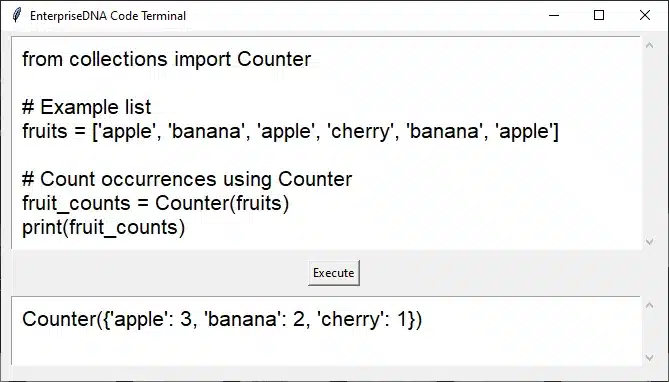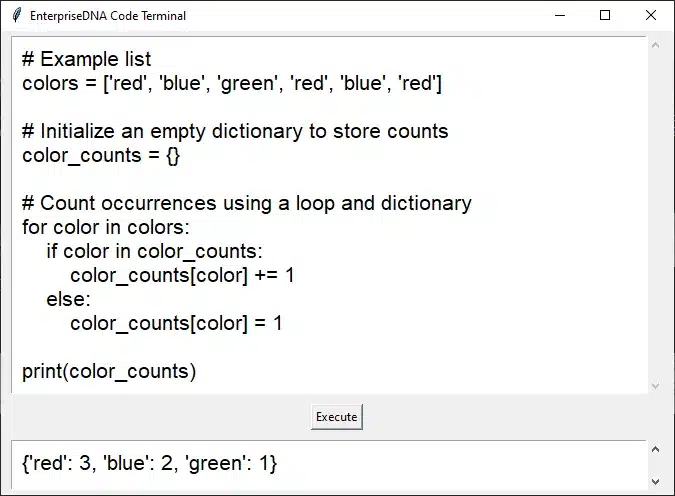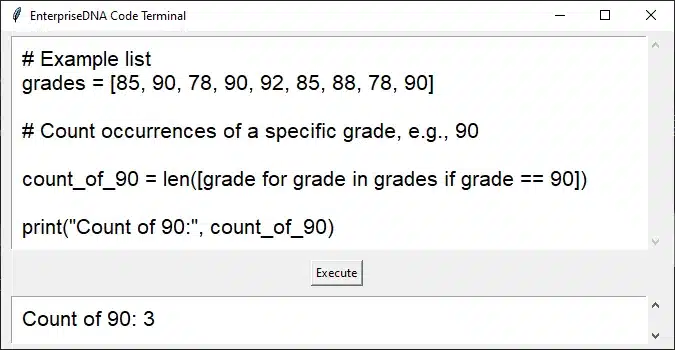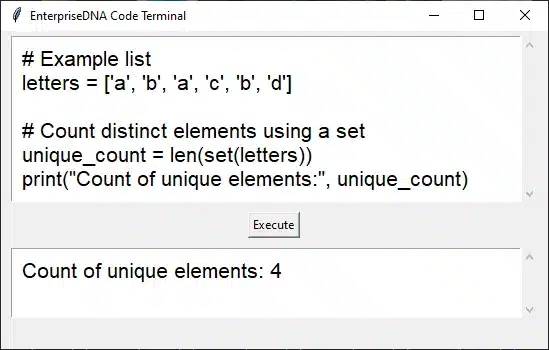If you are a coder who knows Python, you might be aware of one of its best features: its ability to perform data analysis tasks, such as counting occurrences in a list.
So, how can you count the number of occurrences in a list using Python?
To count how many occurrences in a list, you can use the following approaches:
Using the Count Function.
Using Counter from the Collections Module
Using a Dictionary
Using List Comprehension
Using a Set
Using the groupby function from Itertools
To know which approach to use, you must consider your data analysis needs regarding speed and resource utilization.
In this guide, we will delve into the 6 best methods mentioned above and provide examples to help you understand each of them better.
So, buckle up and get ready to count occurrences like a pro!
How to Count Occurences in a List

Python provides several methods for counting the number of occurrences in a list. Understanding which methodology to use depends on your data analysis’s needs and requirements.
Let’s explore 6 different ways to count occurrences in a list with Python:
1. Using the Count Function

Dive into the simplicity of the count() function, where finding the frequency of your favorite element in a list is just a command away!
The count() function can count how many times a given number appears in a list. It takes an element as an argument and returns the number of occurrences of that element in the list.
Let’s explore an example:
How to use the count function

This method is simple, but it still has some drawbacks. For instance, it only works with lists and numbers, so it may not be suitable for more complex data structures or diverse data types.
Next, we delve into the Collections Module’s Counter function, offering a sophisticated way to count elements in various Python data structures.
2. Using Counter from the Collections Module

Discover the power of Python’s Counter from the collections module, where every element’s tally is at your fingertips.
The Counter function from the collections module can count occurrences of elements in a list. It returns a dictionary where the keys are unique elements in the list, and the values are the counts of each element.
How to use the collections Counter

This implementation is strikingly effective when counting the occurrences of a single or multiple target values.
Shifting our focus to dictionaries, we’ll see how a more hands-on approach can effectively tally occurrences in a list.
3. Using a Dictionary

Another way to count occurrences in a list is to use a dictionary. This method is similar to the Counter function from the collections module but requires more manual work.
Unleash the versatility of dictionaries for a personalized approach to counting. It’s all about tailoring the count to your unique data needs!
Let’s see how we can make use of a dictionary:
How to get Occurrences with a dictionary

This method can be pretty effective when you need more control over the counting process.
However, it also requires more manual work than other methods, making it less efficient when dealing with larger or more complex lists.
Now, let’s examine list comprehension.
4. Using List Comprehension

Embrace the elegance of list comprehension for counting occurrences. A perfect blend of brevity and functionality for the modern coder!
List comprehension is a concise way to count occurrences in a list based on a condition.
Let’s take a deeper look:
How to use list comprehension

This method is proper when you want to count occurrences that meet specific criteria.
Turning to using sets, we explore an efficient way to count unique elements within a list.
5. Using a Set

Step into the world of sets to effortlessly identify the distinct elements in a list. While this method doesn’t give you the count of each component, it’s handy when you need to know the number of unique elements.
Let’s see how we can use set() to get the occurrences:
How to Get Occurrences with a Set

This method efficiently finds the count of unique values in a list.
Lastly, we’ll explore the groupby function from itertools, an excellent tool for counting consecutive occurrences in sorted lists.
6. Using the groupby function from Itertools

Explore the sequential sorcery of groupby from itertools. Perfect for when your data’s story is told in consecutive chapters.
The groupby function from the itertools module can be used to group and count consecutive occurrences of elements in a sorted list.
Let’s see how to use Groupby for our task:
How to get Occurences with Groupby

This method is proper when you need to count consecutive occurrences of elements in a sorted list.
These additional methods provide various ways to count occurrences in a list, each with advantages and use cases.
Exploring various methods to count occurrences in Python lists, let’s now reflect on some of these main takeaways.
Final Thoughts

In Python programming, counting occurrences in a list is a task that often emerges during data analysis and manipulation. Python offers multiple approaches to tackle this challenge, each with strengths and suitability for different scenarios.
As we’ve explored in this guide, you can use the count() function as a straightforward and simple way to count occurrences, especially when dealing with basic data structures.
The Counter function from the collections module is a powerful tool, providing a dictionary with item frequencies, making it ideal for a wide range of scenarios.
Also, using a custom dictionary approach also grants you more control over the counting process, although it may require additional manual work.
The key to success in counting occurrences in a list is to choose the method that aligns with your specific data analysis needs, considering factors like speed, resource utilization, and data complexity.
So, the next time you need to count occurrences in a list, remember the tools at your disposal and choose the approach that suits your data analysis challenges like a pro.
Happy coding and counting!
To stay up-to-date with the latest AI tool that simplifies Python functions, make sure to check out EnterpriseDNA’s YouTube channel.
Frequently Asked Questions:
How can I count the occurrences of a particular element in a Python list?
Use the count method to count occurrences of a particular element in a Python list. For example, your_list.count(element) returns the number of times the element appears in your_list.
What is the Counter class in Python, and how is it used for counting elements in a list?
The Counter class, part of Python’s collections module, helps count hashable objects. It transforms a list into a dictionary with elements as keys and their counts as values.
How do I use the count method for a Python list?
Use the count method by calling list_name.count(x), which returns the number of times x appears in list_name.
What’s a counter variable, and how is it used in counting occurrences in a list?
A counter variable is typically used in a loop to keep track of the number of occurrences of an item. Each time the item is found, the counter is incremented.
How do I find the most frequently occurring element in a Python list?
Use the Counter class to count elements and its most_common(1) method to find the most frequently occurring element.
Can I count multiple items at once in a Python list?
Yes, use the Counter class from the collections module to simultaneously count occurrences of all items in a list.
Can dictionary comprehension be used to count occurrences in a list?
Yes, dictionary comprehension can be used. For example: {x: list_name.count(x) for x in set(list_name)} creates a dictionary with elements as keys and their counts as values.
How can I count the number of times each element appears in a list?
Use the Counter class from the collections module, which will return a dictionary with each element as a key and its count as the value.
What’s the best method to count occurrences of elements in a list of integer values?
The best method depends on the context, but the Counter class is generally efficient for counting elements in a list of integers.
Can I use the count method to find the occurrences of a specific element in a string or a list?
Yes, the count method works for both strings and lists in Python. For a list, list.count(element) will give the count of element in the list.








